A toothpick worked best for picking the clumps of buffing compound out of the grooves. A toothbrush and paintbrush cut short got some of it out but a q-tip mounted in the dremel worked better and was less work. Anyhow, the rough finish in the grooves is proving to be a real bear to clean. Off to the local hardware store for some small water color brushes and small sharpies.
Good ole Sharpie. They have all kinds of uses.
This is a first as the AWA not only approves but complements them. Huge Fonzy thumbs up.
Zoomed in to show the difference between no padding in the grooves (light blue), all grooves stuffed with felt (purple), and all grooves stuffed with super sized yarn (red). Not a lot of difference between materials but there is a difference with vs without.
I think I'm starting to see a pattern here. Another build with a trough between ~1-5k. Right or wrong, I don't know. It just sounds better to me. More relaxed.
Its right. I've never really strived to get it flat. My ear likes the "BBC dip". The PA monitors I just built were pretty flat, and sounded like it. I ended up relaxing the middle a bit.
Thinking I may need to clean up that hump around 8k. The woofer has large plateaus at ~70-120 and again at 170hz. but other speakers have shown the same behavior in this room. Will have to play around with placement and get some outside measurements when the weather and blood sucking parasites subside.
Agreed, playing around with the minidsp my ears generally point to a recessed area from ~1 - 8k. Wider than a bbc dip. Maybe it's due to aggravating my tinnitus?
That is simply amazing. A very small amount of padding in the grooves shifts the curves down by 1 to 2dB! Much of what we are hearing at higher frequencies appears to be time delayed reflections off the solid baffle surfaces. Thanks for sharing.
Takes ~4½' of yarn/felt to fill the grooves. Measurements were taken at 1 meter on tweeter axis and the mic was not moved during the session. Needless to say, I could have made a mistake somewhere. Also, I should have taken off axis measurements before vs after as I'd wager there's a lot more going on there.
Liking the mid/top but this is bothering me. There is a large hump ~80-120hz. Haven't had a chance to measure these outside, but looking at other speakers measured in this room, part of the issue is the room, but not all of it. Is there an easy way to knock that hump down either in the crossover or internal to the speaker? Adding stuffing did nothing. A sock stuffed in the port helped but costs too much low end.
Smoothed but gated 100ms.
Move the mic a foot or two, see what happens. Then do it again and again. If you sit and listen and it doesn't drone annoyingly, it is likely you really don't have an issue except in that one point in the 3D space you listen in.
Measure normal quasi-anechoic gated and use 1/6 octave resolution, just to get an overall general FR. Measure woofer nearfield and splice the 2 curves around 400-500 Hz. I find that gives pretty accurate results.
But Chahly - Stahkist don't want speakers that look good, Stahkist wants speakers that sound good!
For room response I recommend ungated measurement - 100ms might sound like a good number but there is a difference when you change that to 2000ms to effectively remove any gating.
If you suspect the cabinet tuning is way off, try measuring nearfield and combining port output to verify the cab response without room interaction. A longer port could be a solution. What midbass is being used here?
Jr, from the listening seat, it drones. More so than usual for this room/placement/seating position.
dcibel n John, it's the MCM closeout AudiblePhysics cp 6.5. The tuning should be spot on as I had to do an appendectomy to shorten the original port but it would not be the first time I screwed something up. I'll remeasure nearfield and port.
Right now I have to get stuff ready for tomorrow's ride so this will wait till next week.
Krap. 11 hr days plus Saturday and Sunday. Yep, not getting any measurements done this week.
Ever had a couple lazy and utterly useless coworkers do everything they could to get out of work, including putting more work on you and then making it look like you are the problem? "I've had all I can stands and I can't stands no more!"
There are some PPG pearls chameleon flakes and shimmers on ebay that really pop. They retail for as much as $900 for 6oz but with a bit of luck $60 may just do it.
Hey, hey, got the day off. Take a few measurements, eat, then heading to the creek.
Wow, have to do something with port noise. The problem area would be right around where the port and woofer outputs cross. The mic is ~1/4" from the dustcap and just inside the port.
The walls are lined with various thicknesses of denim insulation. Should I stuff a little fiberglass in the port for the noise? Maybe a divider in the port?
From the measurements, does anyone see a reason for the large hump from ~75-120hz. posted earlier?
Not in the port, back wall in front of it if there's room. I haven't experimented with the denim stuff, but FG/Roxule behind the woofer should control any mid junk from escaping the port. 120hz is gonna be hard to deal with, with damping material.
Can you put some damping material between the port and the woofer and not hinder the free flow of air to the port. I would not recommend putting something in the port.
There looks like some kind of resonance going on with the peak of the port noise corresponding to a small peak in the woofer response.
A zoomed in impedance sweep can give a lot of insight into internal cabinet reflections, simply compare the woofer impedance in free air to in-box and look at the small bumps in the impedance, any new ones that appear when the speaker is in the cabinet are a result of reflections making their way back to the cone.
I was reminded the other day about taking a quasi near field measurement an equidistant between the port and woofer aka "side" measurement for rear ports. That might help here.
Yes John, measurements are without changing anything other than the mic position.
I'll try that dcibel. Here's the .zma zoomed in.
And John again ... I have the dayton umm-6 usb mic and it is fairly directional. Not sure how to get a good measurement from it trying to measure at that point. Maybe it's time to get a better mic? Umic-1?
1 ohm per division is usually what I go for, and unsmoothed.
At 100Hz, 1/2 wavelength is 67.8", and 1/4 wavelength is 33.9". Not sure how tall your cabinet is, but with the driver at the top and port at the bottom, you may be getting some transmission line effects.
Here's what I mean on cabinet reflections. This bump at 200Hz is a cabinet reflection, as this bump does not exist in the free air impedance sweep. This is a tall cabinet, and was not well damped when this measurement was taken.
The other option was to measure inside the speaker without blocking the port per Andrew Jones. I think Craig @PWRRYD tried this. I haven't found the need to drill a 1/2 inch hole in my speakers to test this.
Finally ... a couple days off.
Thinking about what dcibel said. Woofer and port are ~21" apart and the problem area is roughly 75-120hz. The ¼ length for 160hz. is ~21" There is a spike at ~160hz. but not the major contributor. The ¼ length for 75-120hz is ~45"-28" so quite a bit longer than the 21" driver/port placement. Am I on the right track thinking this is not an accidental TL?
Taking a closer look at Unibox, it shows a port resonance at ~700hz. Is it possible the peak at 730hz. is just port resonance? Can something as simple as stuffing a divider into the port eliminate this?
I'll do more measurements and experimenting after everyone gets out of bed.
I've been reading and re-reading this thread, trying to figure out what the problem could be that is causing the huge boom in the 75-120Hz area. But I am coming up empty. Your NF port and cone measurements do not seem to have any major glitches that could be causing this. Could you post your complete Unibox model? The port resonance at 700Hz is clearly showing up in your measurements, but that is probably not your problem. By a divider, do you mean a trap? A trap could be tuned to eliminate this, but a trap is difficult to tune when the port is located inside the box.
Comments
A toothpick worked best for picking the clumps of buffing compound out of the grooves. A toothbrush and paintbrush cut short got some of it out but a q-tip mounted in the dremel worked better and was less work. Anyhow, the rough finish in the grooves is proving to be a real bear to clean. Off to the local hardware store for some small water color brushes and small sharpies.
Good ole Sharpie. They have all kinds of uses.
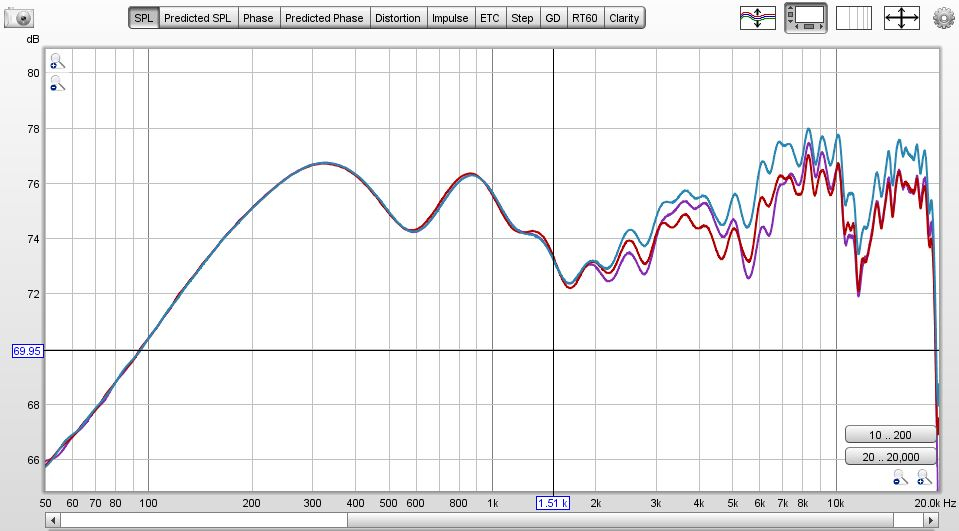
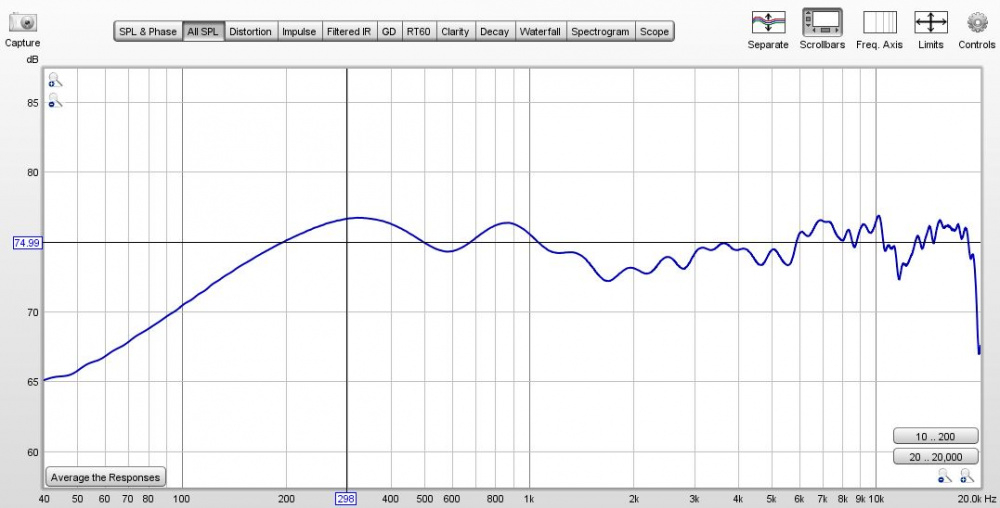
This is a first as the AWA not only approves but complements them. Huge Fonzy thumbs up.
Zoomed in to show the difference between no padding in the grooves (light blue), all grooves stuffed with felt (purple), and all grooves stuffed with super sized yarn (red). Not a lot of difference between materials but there is a difference with vs without.
I think I'm starting to see a pattern here. Another build with a trough between ~1-5k. Right or wrong, I don't know. It just sounds better to me. More relaxed.
Its right. I've never really strived to get it flat. My ear likes the "BBC dip". The PA monitors I just built were pretty flat, and sounded like it. I ended up relaxing the middle a bit.
Thinking I may need to clean up that hump around 8k. The woofer has large plateaus at ~70-120 and again at 170hz. but other speakers have shown the same behavior in this room. Will have to play around with placement and get some outside measurements when the weather and blood sucking parasites subside.
Agreed, playing around with the minidsp my ears generally point to a recessed area from ~1 - 8k. Wider than a bbc dip. Maybe it's due to aggravating my tinnitus?
That is simply amazing. A very small amount of padding in the grooves shifts the curves down by 1 to 2dB! Much of what we are hearing at higher frequencies appears to be time delayed reflections off the solid baffle surfaces. Thanks for sharing.
Takes ~4½' of yarn/felt to fill the grooves. Measurements were taken at 1 meter on tweeter axis and the mic was not moved during the session. Needless to say, I could have made a mistake somewhere. Also, I should have taken off axis measurements before vs after as I'd wager there's a lot more going on there.
Liking the mid/top but this is bothering me. There is a large hump ~80-120hz. Haven't had a chance to measure these outside, but looking at other speakers measured in this room, part of the issue is the room, but not all of it. Is there an easy way to knock that hump down either in the crossover or internal to the speaker? Adding stuffing did nothing. A sock stuffed in the port helped but costs too much low end.
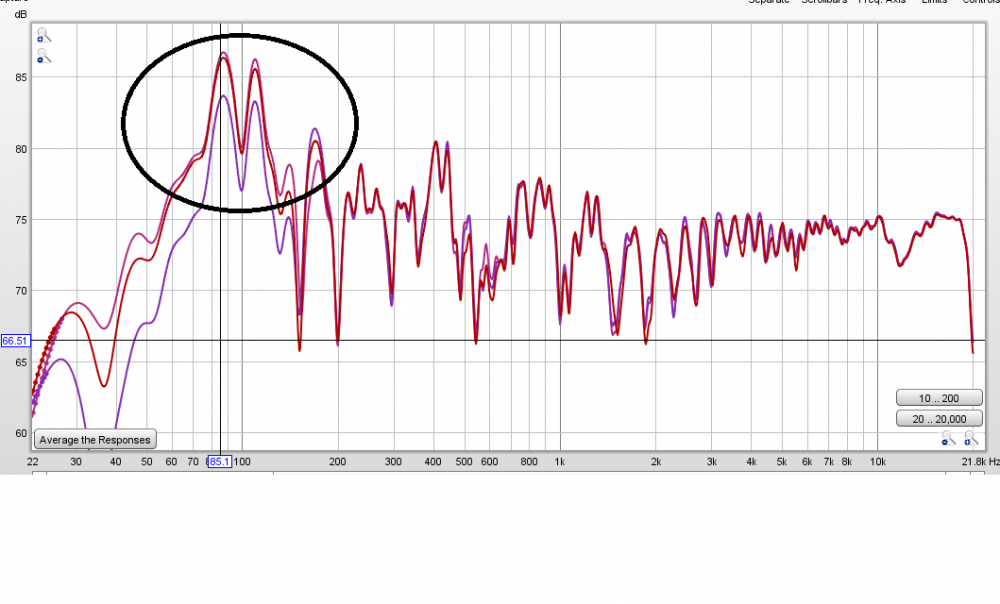
Smoothed but gated 100ms.
Move the mic a foot or two, see what happens. Then do it again and again. If you sit and listen and it doesn't drone annoyingly, it is likely you really don't have an issue except in that one point in the 3D space you listen in.
Measure normal quasi-anechoic gated and use 1/6 octave resolution, just to get an overall general FR. Measure woofer nearfield and splice the 2 curves around 400-500 Hz. I find that gives pretty accurate results.
Does it sound like a small boombox in the bass?
For room response I recommend ungated measurement - 100ms might sound like a good number but there is a difference when you change that to 2000ms to effectively remove any gating.
If you suspect the cabinet tuning is way off, try measuring nearfield and combining port output to verify the cab response without room interaction. A longer port could be a solution. What midbass is being used here?
Near field should show the issue as this is below the baffle step.
Jr, from the listening seat, it drones. More so than usual for this room/placement/seating position.
dcibel n John, it's the MCM closeout AudiblePhysics cp 6.5. The tuning should be spot on as I had to do an appendectomy to shorten the original port but it would not be the first time I screwed something up. I'll remeasure nearfield and port.
Right now I have to get stuff ready for tomorrow's ride so this will wait till next week.
Krap. 11 hr days plus Saturday and Sunday. Yep, not getting any measurements done this week.
Ever had a couple lazy and utterly useless coworkers do everything they could to get out of work, including putting more work on you and then making it look like you are the problem? "I've had all I can stands and I can't stands no more!"
There are some PPG pearls chameleon flakes and shimmers on ebay that really pop. They retail for as much as $900 for 6oz but with a bit of luck $60 may just do it.
What's the difference between the holographic and pearl metal flake?
Hey, hey, got the day off. Take a few measurements, eat, then heading to the creek.
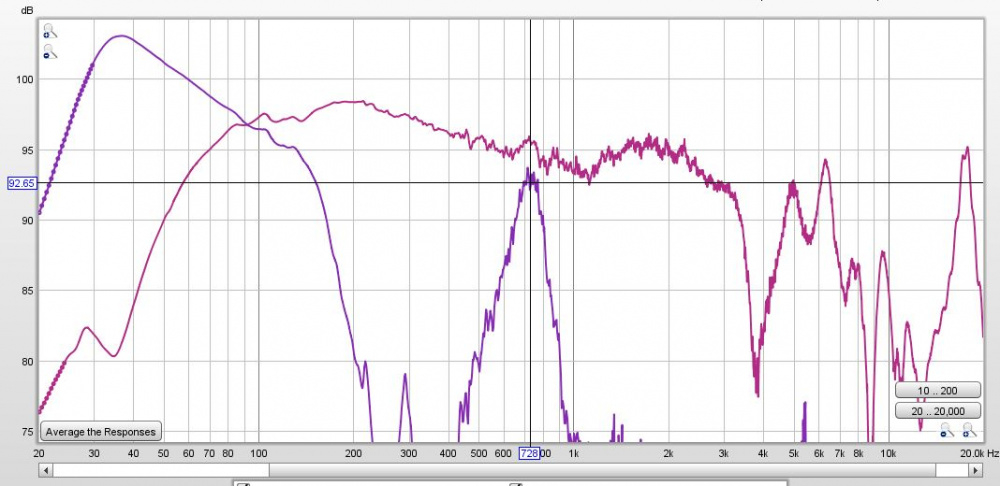
Wow, have to do something with port noise. The problem area would be right around where the port and woofer outputs cross. The mic is ~1/4" from the dustcap and just inside the port.
What damping material you using? My opinion, FG/Rockwood is best for port noise control.
The walls are lined with various thicknesses of denim insulation. Should I stuff a little fiberglass in the port for the noise? Maybe a divider in the port?
From the measurements, does anyone see a reason for the large hump from ~75-120hz. posted earlier?
Not in the port, back wall in front of it if there's room. I haven't experimented with the denim stuff, but FG/Roxule behind the woofer should control any mid junk from escaping the port. 120hz is gonna be hard to deal with, with damping material.
Can you put some damping material between the port and the woofer and not hinder the free flow of air to the port. I would not recommend putting something in the port.
There looks like some kind of resonance going on with the peak of the port noise corresponding to a small peak in the woofer response.
Ron
My thought is the port looks high because its not spl matched. I'd target the 200 Hz bump
Port SPL needs to drop about 12dB, then merge with nearfield to get the full nearfield response. I explained how to adjust the port SPL a bit over here:
https://diy.midwestaudio.club/discussion/comment/22901/#Comment_22901
A zoomed in impedance sweep can give a lot of insight into internal cabinet reflections, simply compare the woofer impedance in free air to in-box and look at the small bumps in the impedance, any new ones that appear when the speaker is in the cabinet are a result of reflections making their way back to the cone.
I was reminded the other day about taking a quasi near field measurement an equidistant between the port and woofer aka "side" measurement for rear ports. That might help here.
Yes John, measurements are without changing anything other than the mic position.
I'll try that dcibel. Here's the .zma zoomed in.
And John again ... I have the dayton umm-6 usb mic and it is fairly directional. Not sure how to get a good measurement from it trying to measure at that point. Maybe it's time to get a better mic? Umic-1?
1 ohm per division is usually what I go for, and unsmoothed.
At 100Hz, 1/2 wavelength is 67.8", and 1/4 wavelength is 33.9". Not sure how tall your cabinet is, but with the driver at the top and port at the bottom, you may be getting some transmission line effects.
Here's what I mean on cabinet reflections. This bump at 200Hz is a cabinet reflection, as this bump does not exist in the free air impedance sweep. This is a tall cabinet, and was not well damped when this measurement was taken.
Mic should be fine. This is what I was talking about wrt to your design.
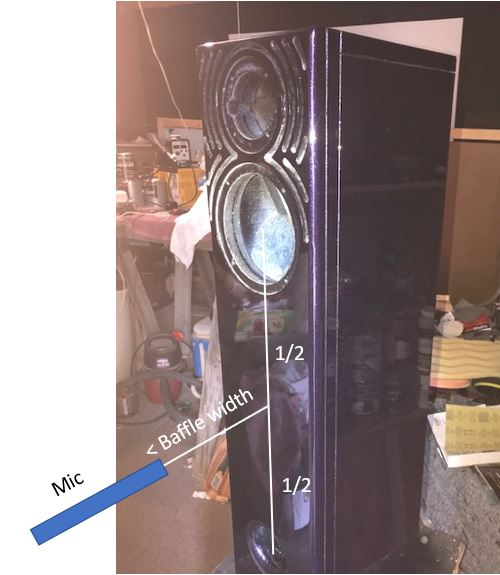
The other option was to measure inside the speaker without blocking the port per Andrew Jones. I think Craig @PWRRYD tried this. I haven't found the need to drill a 1/2 inch hole in my speakers to test this.
Finally ... a couple days off.
Thinking about what dcibel said. Woofer and port are ~21" apart and the problem area is roughly 75-120hz. The ¼ length for 160hz. is ~21" There is a spike at ~160hz. but not the major contributor. The ¼ length for 75-120hz is ~45"-28" so quite a bit longer than the 21" driver/port placement. Am I on the right track thinking this is not an accidental TL?
Taking a closer look at Unibox, it shows a port resonance at ~700hz. Is it possible the peak at 730hz. is just port resonance? Can something as simple as stuffing a divider into the port eliminate this?
I'll do more measurements and experimenting after everyone gets out of bed.
I've been reading and re-reading this thread, trying to figure out what the problem could be that is causing the huge boom in the 75-120Hz area. But I am coming up empty. Your NF port and cone measurements do not seem to have any major glitches that could be causing this. Could you post your complete Unibox model? The port resonance at 700Hz is clearly showing up in your measurements, but that is probably not your problem. By a divider, do you mean a trap? A trap could be tuned to eliminate this, but a trap is difficult to tune when the port is located inside the box.